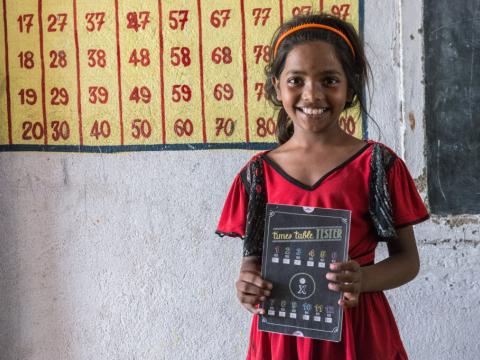International Day of the Girl Child: Getting girls in the classroom and keeping them there

The United Nations has declared 11 October as International Day of the Girl Child to recognise girls’ rights and the unique challenges girls face around the world.
According to UNESCO, there are over 130 million girls between the age of 6 and 17 who are out of school. Nine of the top 10 most difficult nations for girls to be educated are in sub-Saharan Africa. Those from the poorest families are more likely to be out of school than their peers from more affluent communities. Girls face a slew of barriers to their access and success in a safe educational environment, causing a disparity in outcomes when compared with boys.
Education programming that targets girls has far reaching effects for their community and nation at large. For example:
- A woman who receives formal education is more likely than an uneducated woman to use contraception, marry later, have fewer children, and be better informed on the nutritional needs of her children.
- Education empowers a girl to build a better life for herself, contributing to the health, safety and prosperity of her family and community. A one percentage point increase in female education rates raises the average GDP for her country by 0.3 percentage points.
- Women invest 90 per cent of their income in their households, as opposed to men’s 30-40 per cent, leading to healthier, better educated children and families.
- Education, for any child, can open the doors to a brighter future that would otherwise be locked tight. But it isn’t just about the future – children who stay in school are better protected from exploitation in the present. When girls have access to education, they develop the knowledge, confidence and life skills necessary to navigate and adapt to an ever-changing world..
A multitude of barriers
In spite of the overwhelming evidence supporting the importance of educating girls, a number of challenges remain which hinder their access to quality education:
- Each year, 12 million girls are married before the age of 18. Early marriage often results in girls experiencing early pregnancy and dropping out of school.
- Challenges with menstrual hygiene management in schools means that, in many contexts, girls simply do not go to school when they are menstruating, missing significant instructional time each month.
- Many girls must travel unsafe distances to attend school.
- Girls experience violence at schools in the form of sexual harassment and abuse by teachers and peers, and are often pressured to engage in transactional sex for good grades.
- When forced by poverty to choose who will attend school, families often prioritise boys over girls.
What’s more, girls are known to experience school differently than boys. Girls are often treated differently by teachers, and may be called on less than boys to answer questions. Attitudes of teachers and curriculum materials often perpetuate harmful gender norms thus disempowering young girls. In addition, the lack of female teachers or other role models can discourage girls from remaining in school.
What is World Vision doing to help girls learn?
World Vision is a champion for girls’ education in the communities where we work. We identify and break through the barriers that keep girls out of school. This requires involving key people in the ecology of a girl’s life and community such as families, schools, churches, governments, traditional leadership, boys and men—and the girls themselves—to understand the value of education in girls’ lives.
We work across sectors to prevent gender based violence, nurture safe school environments, create separate WASH facilities in schools, and provide school feeding and nutrition services. Our work with local and international education ministries ensures that teachers have the tools they need to improve their classroom environments.
By creating locally relevant and age-appropriate learning materials, children can learn what they need to know in their native language. And by collaborating with other experienced organisations in the field, we’re able to reach more broadly to help implement successful education initiatives in the countries where we work.
We are committed to empowering girls to identify and tackle hindrances affecting their school attendance and abilities to learn so they finish their secondary school education and experience life in all its fullness.